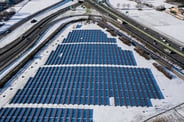The energy retail market is going through a turbulent time, with many suppliers pushed out of business by soaring gas prices. But alongside the immediate ups and downs of wholesale energy, there are more long-term changes that will change the sector for good.
The biggest problem facing the world, bigger than the Covid pandemic or the need for energy security, is climate change. And businesses are under increasing pressure from customers, shareholders and investors to become part of the solution by cutting emissions. Vague promises to be greener will no longer work, as the public becomes increasingly knowledgeable and aware of greenwash. Many businesses have responded by signing up to external schemes such as the Science-Based Targets initiative, so they can prove that their strategy stands up to scrutiny. And in turn, they look for the same kind of transparency from their energy retailers.
You may already be hearing these questions from your high-volume users. If not, you are sure to start hearing them in the coming months. Do you have your answers ready?
1. What is your plan for days when renewable output is low?
This year’s mild weather means that on many days, the UK’s wind turbines generated only a tiny fraction of their capacity, which is one of the causes of the UK’s current energy problems. Customers are more aware than ever that renewable energy generation is intermittent and dependent on the weather. They want retailers to be upfront about this, rather than simply claiming to offer “100% renewables”. Customers understand that sometimes falling back on fossil fuels is unavoidable, but they want to know how you manage this. Do you have a strategy for maximising the proportion of renewables used by your customers?
2. Can you tell us the source of the energy we’re using in real time?
Clever timing can go a long way to reducing consumption of fossil fuels and boosting the proportion of renewable energy used; for example, a business might choose to schedule energy-intensive operations for a time when there are a lot of renewables in the mix. But it is impossible to do this unless you have access to regularly updated supply data. High-volume customers with smart meters are used to seeing energy measured in half-hourly chunks, and they will want their retailer to offer this kind of granularity when it comes to the sourcing of their energy too.
3. Can you give us data we can read easily?
Smart meter data is crucial to understanding how, when and where energy is being used. But in its rawest form, it isn’t very user-friendly. The government is currently consulting on making it a legal requirement for retailers to offer this data in a more easily readable format. Retailers who wait for the government to force them to make this change are missing out on the chance to get ahead of the competition, and meet this growing customer need now.
4. How are your REGOs sourced?
Media coverage of REGOs has helped to raise public awareness of how they work, and savvy business users will know that having enough REGOs in your possession to market your tariff as renewable doesn’t necessarily mean you have been buying energy directly from renewable generators. As they come under pressure to be transparent about their own climate strategy, they will expect similar transparency from you as their retailer.
5. How will buying our energy from you help us meet other sustainability goals?
For many businesses, their plan to reduce emissions is part of a broader framework of goals about having a positive impact on the world. These may be aligned to the United Nations Sustainable Development Goals (SDGs) or they may be independently conceived. If one of the goals is to be a good citizen of the local area, the business may want to support local green energy projects through its energy supply. But it can only do this if their retailer offers detailed data on its sourcing. Can you offer this?
Trend report for energy retailers
High-volume business users are definitely more demanding customers than in the past, asking tougher questions rather than simply focusing on price. This can be challenging for retailers, but those who understand their customers’ changing priorities will find themselves at a significant competitive advantage.
To learn more about how you can meet the changing needs of net zero consumers, download our free report: Trends and opportunities for energy retailers in a net zero market. And find out why energy retailers need to change the way they operate – and how to do it today.



